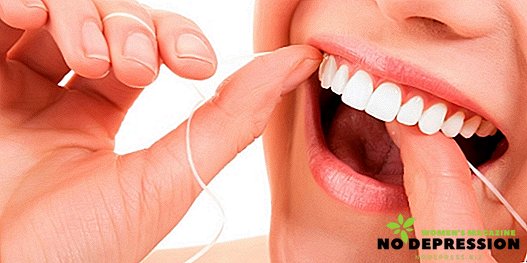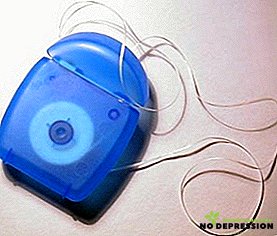In pursuit of a dazzling Hollywood smile, we forget about an important detail - the health of teeth and gums. Perfect prevention without the intervention of dentists in this matter will serve as dental floss (floss).

Classification
Floss is a special thread for cleaning approximate surfaces (interdental spaces). There are different types that differ in some criteria and have their own scope of applicability.
A variety of dental floss is distinguished by several parameters:
- Cross section: flat, round, volumetric. To care for the narrow distances between the teeth, flat floss should be used; round created specifically for wide interdental spaces; volume increases with saliva soaking, making it easy to clean any teeth;

- The surface treatment distinguishes between unwaxed and waxed ones - the first ones are covered with wax and easily penetrate into hard-to-reach places, but they don’t make it possible to remove plaque qualitatively, the waxed version fights plaque and the smallest dietary fibers much better. Waxed threads will suit people with a large number of fillings, and beginners should pay attention to the second category;
- Presence of impregnation: without impregnation or impregnated. Threads are impregnated with a medicinal composition, which increases the effect during cleansing and strengthens the gums and enamel;
- Sphere of use: home conditions, dentists.
Features and need for use
Floss in our time - one of the main tools in the fight for a healthy oral cavity, so it is advisable to use the thread in order to prevent a healthy, flawless smile.
The limitation of a toothbrush does not allow to achieve one hundred percent effect.
Two of the five tooth surfaces are inaccessible to eliminate plaque and food debris, which often leads to caries in these places.
Cleaning floss before using a toothbrush has a double effect. It is not only possible to remove lost parts of food, but also to allow active substances to get closer to the gums.

Instructions for use step by step
Proper use of dental floss allows you to get rid of plaque, to prevent the development of caries and gum disease. For best results, you should read and follow the step by step instructions. Here's how to properly use dental floss:
| 1 | Take about 45 cm of floss; |
| 2 | Wind on middle fingers about 90% of the entire length, the rest is brushing; |
| 3 | Grab the thread between your index and thumbs, stretch it; |
| 4 | Next, gently, without sudden movements, move the thread up and down between the teeth; |
| 5 | To remove plaque, it is preferable to stretch the floss with the letter "c" between the tooth and use the same technology to clean it; |
| 6 | Plots of the used thread should be moved away on one of the middle fingers, or wound on the index finger, since new areas are recommended to be treated with a clean thread. |
Tip: You can come up with a special sequence of actions, so as not to miss a single tooth.
With this simple algorithm, you will learn the techniques of cleaning flossing. Most importantly, do not forget about the farthest teeth and wisdom teeth, because most of the diseases begin to progress in these places.

How to use dental floss with braces
If you are the owner of metal braces, then use a dental floss is not only possible, but necessary. For this case, there are two methods: the usual actions of a floss or the development of a special propetera
In the case of the classical method, the main points of use remain the same as with ordinary cleaning. It is important to pay attention to the following points:
- with braces, attention should be paid to the waxed thread, since the braces have pointed edges, the wax thread will better slide over their surface and not tear;
- Be sure to thread the floss under the wire arch of the braces, you need to do this carefully, do not touch the arc, otherwise the thread may break or get stuck. It is best to thread in the place where there is the largest gap, so that it is convenient to catch the tip of the floss;
- push the thread into the gap between the teeth and make smooth movements up and down;
- pull the floss slowly, trying not to touch the braces. Now this operation is carried out on all teeth.

This method may seem long, to speed up the process, you can learn how to use a thruster. This is a special plastic needle with an eye in which the thread is passed.
There is also another kind of floss - dental tape. This type is much wider, thinner and easier to use. Terms of use are similar.
Frequent problems and solutions
Using dental floss is not difficult, but people often have the same obstacles, fortunately, most of which can be solved.
The appearance of pain or bleeding
Such signs may indicate gingivitis (inflammation of the gums). Despite the fact that the dental floss has a painful effect, this does not mean an immediate cessation of its use.
Try to use daily hygiene products for the oral cavity: a toothbrush, rinse aid, floss. These manipulations prevent the onset of these symptoms. However, if within one or two weeks, the pain and bleeding does not pass, you should contact a specialist.
The proximity of the teeth
For this case, it is desirable to use a thread treated with wax or from Teflon (flexible, elastic substance), both types will facilitate easy glide over the teeth. And you can always contact your dentist, he will advise you on your choice and will offer different samples.

Not enough dexterity
For people with impaired coordination, the presence of a disease that interferes with proper use, a device has been manufactured to support floss. The holder is made in the form of the letter Y. The thread is fixed on the upper part of the structure, which allows for cleaning with one hand.
No time to use
The preferred application time is up to 5 minutes, but if you don’t even have it, you can spend at least 60 seconds, and this will greatly benefit your teeth.
And if the food does not fall between the teeth?
In addition to removing food debris, floss removes accumulated plaque, which is one of the causes of gingivitis, paradontosis (damage to the dental-toothed tissue) and, eventually, the loss of teeth.
Frequency of use
How often should flossing be used? Yes, the more the better.
The best option is to use the floss after each use of food. After all, in this way, it is possible not only to eliminate the stuck pieces, but also to prevent bacteria from developing.

If it is not possible to carry out this procedure so often, then it will be most effective to use a thread before nightly brushing your teeth, since it is during sleep that bacteria multiplication becomes much more active.
Can everyone use floss
Dental floss is a very useful thing, but is it suitable for everyone?
If a person already has one or several diseases: chronic paradontosis, periodontitis (inflammation of the supporting apparatus of the teeth) or gingivitis - you need to minimize the activity of use and consult with a specialist.
For healthy teeth and gums there is no prohibition, because it is the prevention of certain diseases and unpleasant smell from the mouth.
The thread is intended for both adults and children who can independently and consciously approach this business.
Acquainted with such a finding in the field of oral hygiene - dental floss, its types, instructions for use and purpose, everyone can easily determine whether he should take this thing into his arsenal.
The following video is very clearly shown how to use dental floss.













